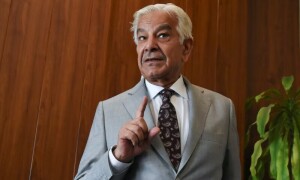EXTREMIST militants receive considerable support from their apologists who take exception to criticism of religious extremism and claim this is not the only form of extremism. The point is valid though there can be no bar to examining faith-based intolerance alone. A brief inquiry will show that the various forms of extremism have common roots.
For want of a standard definition in the context of Pakistan’s environment, extremism may be defined as irreconcilable hostility to other people’s religion or sect, their culture and customs, rejection of the rights of minority communities and women, and determination to convert them through inducement or intimidation or eliminate them through physical violence, including terrorist acts.
Women constitute the largest single group of people in Pakistan that are victims of extremists’ violence. A recently released report of a survey conducted by the United Nations Population Fund (UNFPA), in cooperation with the Bureau of Statistics and the Punjab Commission on the Status of Women, shows that one-third of women in Punjab, aged 15 to 64, have suffered violence. The situation elsewhere in the country could be only marginally different. Almost every day, the media reports a woman being burnt alive or killed otherwise. The practice of killing women for men’s honour has spread to cities where it was unknown till recently. Women are attacked for choosing their spouses, for failing to meet intermittent dowry demands, and for venturing out wearing clothes and sporting hairstyles tabooed by orthodox priests of morality. There are areas where girls are not allowed to go to school.
Women and girls belonging to bonded labour families, working in agriculture or at brick kilns and in various other sectors, suffer extremists’ excesses in several forms: their labour is exploited, they are denied freedom of movement, they cannot seek alternative employment, and they have no defence against abduction and sexual abuse. Non-Muslim women and girls suffer greater violence than their Muslim counterparts, and those still identified by the state as the scheduled castes suffer much more than upper caste Hindus and other non-Muslim groups.
Can the state be absolved of crime by negligence?
Children outside the category mentioned above constitute another large group that suffers extremists’ violence. A large number of street children suffer economic exploitation and physical and sexual abuse. The number of domestic servants that are subjected to various forms of abuse has been rising for quite some time. The state has failed to eradicate corporal punishment in schools. Only the other day a small girl died after falling (or jumping) from a rooftop. She dreaded going to school where she was mercilessly thrashed for lagging behind in her studies. Her mother added to her misery by tying up her hands and feet and throwing her in a dark room. Enforced disappearances are one of the ugliest forms of extremism.
Now we may take a look at the incidence of faith- related violence. The Hazara Shias are mowed down for their beliefs. Many hate preachers openly instigate murder. The Ahmadis continue to be victims of target killing. The anti-minorities knights are not content with instituting cases under the blasphemy law; they try to exterminate their quarry in police custody or in the street. Anyone acquitted of blasphemy charges cannot find a safe place to live in the country. And there is no doubt that the killing of non-Muslims in prayer houses and Muslims in mosques and schools is done in the name of religion.
Even a cursory reading of the evidence of violence committed by extremists will bring out the fact that use of extremist violence due to completely non-religious factors, such as exploitation of bonded labour and street children, and corporal punishment in schools and even in madressahs, is not unknown in Pakistan. The causes of violence against women include patriarchal excesses, feudal culture and misogynous tendencies, but do not exclude misinterpretation of religious injunctions. As regards the extremists’ and militants’ narrative of terrorism in the name of religion, it has been attributed to a wrong interpretation of Islam by no less an internationally recognised Islamic scholar than Dr Khalid Masud, formerly chairman of the Council of Islamic Ideology and at present a judge of the Shariat Appellate Court.
Unfortunately, the roots of all forms of extremist violence lie in the state’s acts of omission or commission. If women’s suffering due to the curses of patriarchy, misogyny or feudal culture has increased, the state is responsible for having failed to liberate the Pakistani society of anachronistic social mores which are, among other things, one of the major obstacles to the growth of a democratic system and a democratic culture. If children at schools and madressahs are at the mercy of sadists in the garb of teachers, and if savages at institutions of higher learning can kill a student like Mashal Khan and a teacher like Khalid Hameed, can the state be absolved of crime by negligence? The bonded workers, their women folk and their children continue to suffer because their tormentors enjoy political clout. Has the state taken any action to eliminate the worst forms of child labour despite having signed the relevant ILO convention? Can the state wash away the ignominy of allowing enforced disappearances, the ultimate form of extremist violence?
As regards extremist violence in the name of religion, the state has been inviting censure for acts of both omission and commission. On the one hand, it has done practically nothing to save the people from what is described as wrong interpretation of their faith and, on the other hand, it continues to associate with the religious elements that openly denounce democracy, human rights and pluralism. All past governments increased their and the people’s tribulations by appeasing the quasi-religious lobby. It is time the present government asked itself whether it is surpassing its predecessors in pandering to the orthodoxy that has done incalculable harm to Islam and Muslims over many centuries.
Published in Dawn, April 18th, 2019















































